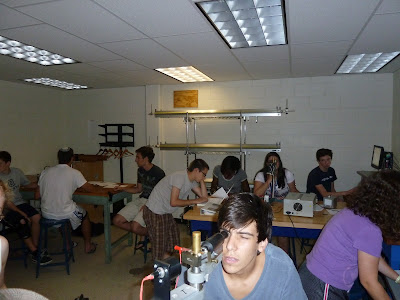Today, class seemed very sporadic. Our topics of discussion were all over the place. First, we began with a discussion about gravitation, which seemed to come out of nowhere. I had learned gravitation in my high school physics class, but we did not spend a very long time on it. We basically only covered a few formulas and constants that we needed to know for standardized testing, but other than that we did not, delve very deeply into the topic. Today was quite different though. Bill was not only thorough in covering the math side of gravitation, but also the conceptual side, despite how vague this subject really is. He explained the inverse square relationships that are involved with gravitational strength and even began discussing Roche Limits. My high school physics teacher told me a little bit about Roche Limits before, but I really wanted to learn more. Today, my thirst for this knowledge was finally quenched. We learned that Roche Limits are the distance within a celestial body, held together by its own gravity, which will disintegrate due to a second celestial body’s tidal forces exceeding the first body’s gravitational attraction. Basically, one object can basically be ripped apart by another object’s gravity if it is pulled upon by a strong enough force. This was my favorite part of today’s lecture.
Following the lecture, we began talking about our field trip to Hershey Park tomorrow. We were presented with a list of rides that we could use for our tests as well as the parameters for our testing. We will have to chart data on the position and acceleration of certain points on our ride. My group, which is composed of Brian, Julia, and Mike, will be collecting data from a ride called the Sooperdooperlooper. We will have to ride the coaster several times to get different sets of data, and then we are free to do as we please in the park. The trips in this program are the best educational field trips I have ever been on.
We continued discussing Hershey Park until our guest lecturer, Dr. Randy Camien, arrived. Dr. Camien is a Soft-Condensed Matter Theoretician…even after his lecture I am still lost as to what that means. His lecture dealt with topology in physics, which concerns the continuous deformation of an object using stretching. The bulk of the information discussed interactions between light and liquid crystals. He explained, at great length, how and why liquid crystals (which are what make LCD screens work) operate the way they do. Liquid crystals operate by blocking certain colors of light and only letting other types through as they contract and expand. Dr. Camien was very interesting to listen to because he was able to draw analogies and examples from a lot of different places and still relate them back to topology. I find that I am enjoying our guest lecturers very much because they bring a new perspective to our class-wide discussion of physics.
Following the guest lecture and lunch, we performed a lab in which we had to measure the speed of electrons. We did this by using microscopic bubbles of oil that were suspended in a confined space using electric current. By increasing or decreasing the voltage, we could get the bubbles of oil to rise or fall, and our task was to measure how fast these bubbles moved. Once Onur, Mike, Lindsey, and I collected our data, we plugged our values for the velocity of the oil bubbles into Excel. Thankfully, the tables were already set up to evaluate the rest of the data that we would need once we plugged in the values for velocity. So, aside from having to strain my eyes by trying to find a tiny bubble of oil through a microscope, this lab was fairly easy. I’m finding that my new lab group is much more efficient than my old one. However, this could just be because we are all in a familiar space and are used to all the equipment by now. Either way, my group is working well.
The rest of the day was very relaxing. Brian and I hung out in our room for a while after class. Later our group enjoyed dinner together, played some Frisbee afterwards, and then we watched the movie Garden State, with Zach Braff and Natalie Portman. It was a great way to conclude the day, especially after the randomness of class. Moving from one topic to another that quickly can be disorienting at first, but I can certainly see the value in it. It forces me to think on my feet and adapt to a new idea or concept. It takes a while to get used to thinking like this, especially since things are so structured in my high school classes, but I am getting used to it. Despite today’s abnormal level of entropy (the physics term for randomness or chaos), it was still enjoyable and I learned a lot from our lab and two lectures. I love this class more and more each day because I am finally able to be immersed in a subject that I am truly passionate about.



